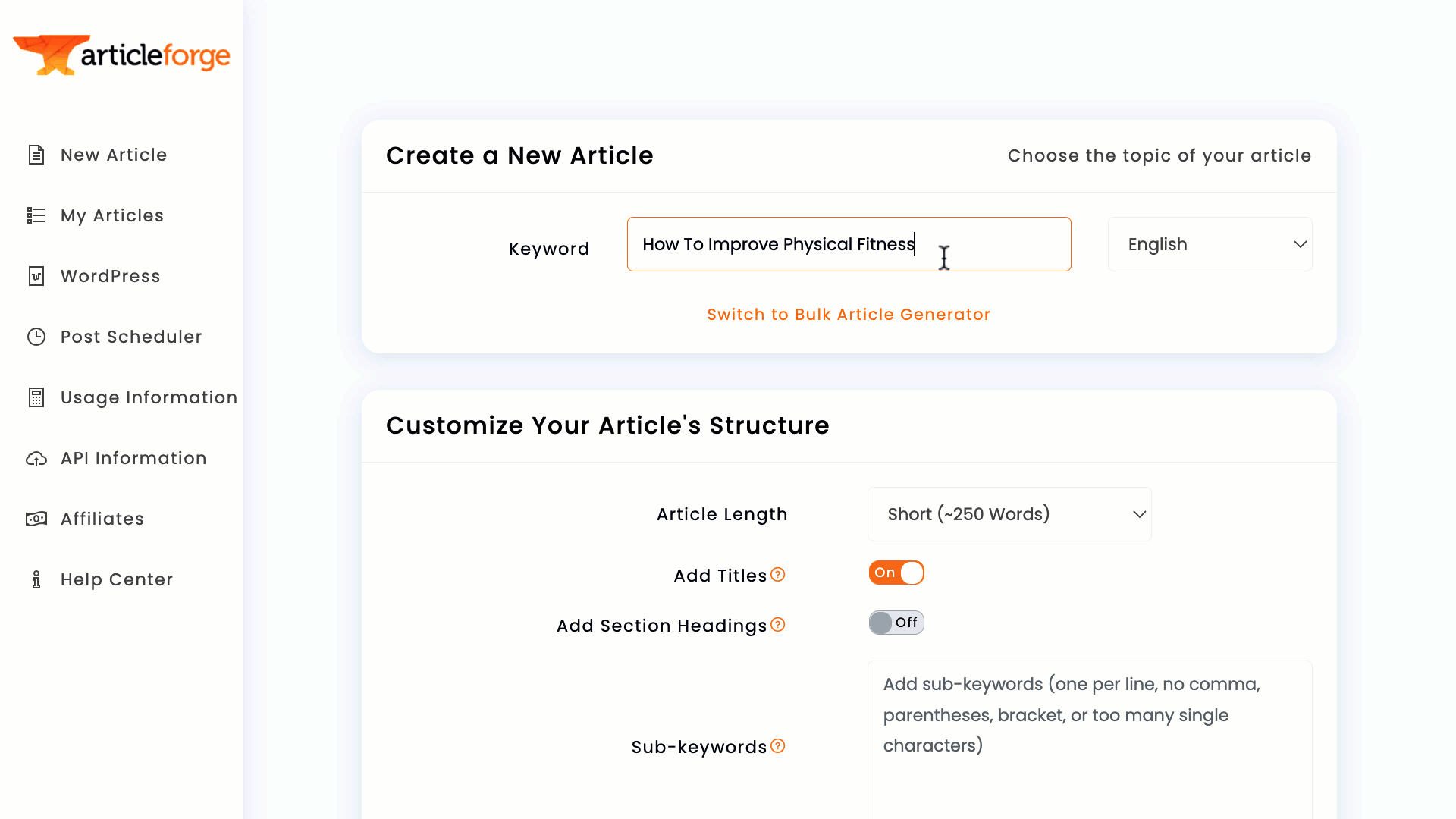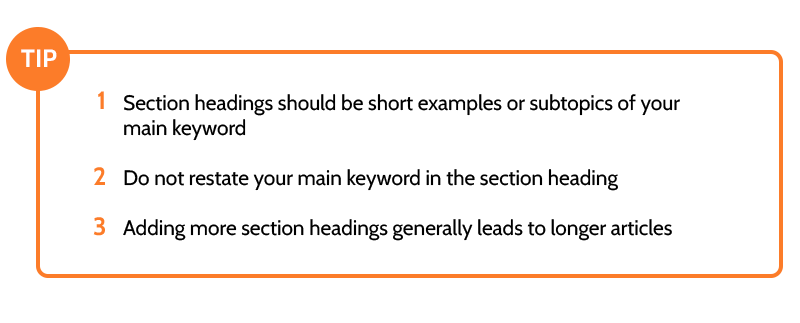Article Forge is the only tool that can generate high-quality 1,500+ word articles automatically.
Without getting into the technical details, this is possible because Article Forge researches your keywords and plans out the full structure of each article - from section topics to the talking points for each paragraph - before it even starts writing.
This means creating 1,500+ word articles with Article Forge is as simple as clicking a button.

But, while you can just enter your main keyword and let Article Forge do all the work, you can also add your own section headings to control what Article Forge writes about.
Depending on how you want to produce your content, there are a few best practices you should follow to make sure you are getting the best possible results from Article Forge.
Quick Tips:
- When entering keywords, you should always be able to imagine a clear direction your article could take.
- For long articles, your main keywords should be broad enough that they could be broken down into sections or subtopics.
- Your section headings should be simple examples or subtopics that relate to your main keyword.
- Your section headings should align with the intent of your main keyword.
Contents:
- How intent impacts articles
- Using auto-generated section headings
- Adding your own section headings
- How intent impacts section headings
- Takeaways
Best Practices
For all content lengths, it is important for Article Forge to understand your intent for the articles you want it to create.
Use the formula below to create your main keywords:

How Intent Impacts Articles
Expressing intent can be as simple as adding a few words to your main keyword and will have a major impact on the direction of your articles.
First, let’s say you want an article about mattresses. Below are a few ways you might enter your keyword:
Bad main keyword (no intent): Mattress Good main keyword: What type of mattress should I buy? Good main keyword: What to look for in a mattress Good main keyword: Best mattress for back pain
Without adding intent, there are hundreds of directions this article could take and Article Forge will not know what information is relevant and what is not. If there is no clear intent, Article Forge will likely write a general article about mattresses or pick a direction to take the article.
While a general description of mattresses may be fine for a 50 or 250 word article, Article Forge might not be able to guess the direction you wanted your 1,500 word article to take.
However, the rest of the main keywords show clear intent, so Article Forge will have a much better idea about what to write. In fact, you can probably guess what the articles will be about just from the main keywords.
Next, let’s say you want an article about a security guard company. The following main keywords will result in significantly different articles:
Bad main keyword (no intent): Security guard company Good main keyword: Hire a security guard Good main keyword: Start a security guard company Good main keyword: How to become a security guard
Finally, maybe you want an article about chiropractic care, the following main keywords will lead to significantly different articles:
Bad main keyword (no intent): Chiropractor Good main keyword: Best chiropractors Good main keyword: Reasons to go to a chiropractor Good main keyword: Types of pain chiropractors treat

Note: for shorter articles, this direction can be pretty specific. But, for longer articles, it is important that the main keyword can be easily broken down into smaller sub-topics. This is especially important when using section headings.
Using Auto-Generated Section Headings
In general, the longer the article, the more subtopics Article Forge will need to write about, so it is important that your main keywords are not too specific.
When Article Forge runs out of things to write about, it will generally stop writing instead of going off topic, making things up, or repeating the same ideas.
So, to create 1,500+ word articles, you need to choose a main keyword that Article Forge can break down into multiple sections.
Bad main keyword (too specific): New York City weather in January Bad main keyword (too specific): Museum of Modern Art hours of operation Good main keyword: What to do in New York City Good main keyword: New York City Museums
Bad main keyword (too specific): Swimming improves cardiovascular fitness Bad main keyword (can be simplified): How to improve physical fitness with swimming, biking, and strength training Good main keyword: Types of endurance exercises Good main keyword: Benefits of swimming Good main keyword: How to improve cardiovascular fitness Good main keyword: How to improve physical fitness
Note: If you are writing shorter articles and are not using section headings, your keywords can be more specific. For instance, “Swimming improves cardiovascular fitness” is too specific for a 1,500 word article with sections, but may make a great 250 word article without sections.

Adding Your Own Section Headings
While you can shape your articles by adding intent to your main keywords, you can further control your articles by entering your own section headings.
When adding your own section headings, think of each as an “instance” or short “example” of your main keyword.
Overall, there are three main tips to keep in mind when entering your own section headings:
- Your section headings should be simple words or phrases that relate to your main keyword - listing short examples or subtopics of your main keyword is the best way to get high quality articles.
- You do not need to restate your main keyword in the section heading, Article Forge already knows that the whole article should relate to that topic.
- Adding more section headings will generally lead to longer articles.
Main keyword: What to do in New York City
Bad section heading (not example of "what to do"): High cost of living Bad section heading (can be simplified): Times Square is a place in New York City Good section headings: Times Square; Central Park; The MET; The Guggenheim Museum; The Empire State Building; Hudson Yards
Main keyword: How to improve physical fitness
Bad section heading (too broad): exercise Bad section heading (do not need the main keyword): How to improve physical fitness with strength training Good section headings: Set Goals; Interval Training; Endurance Training; Strength Training
Main keyword: Reasons to go to a chiropractor
Bad section heading (too broad, unclear): Back Bad section heading (too detailed): Treat back pain caused by sitting at a desk all day Good section headings: Reduce back pain; Reduce stress; Improve sleep; Improve mobility; Non-invasive treatment

Note: The Guggenheim Museum is a great section heading for an article about what to do in New York City, but it might be too specific to be the main keyword for a 1,500 word article.
How Intent Impacts Section Headings
We already covered how the intent of your main keywords will greatly impact the direction of your articles. When entering your own section headings, it is equally important to make sure they align with the overall intent of your main keyword.
Main keyword: Pixel 6 features
Bad section heading: iPhone Good section headings: AI-powered camera, Google Tensor, Live Translate, Music recognition, Battery life
Main keyword: Pixel 6 competitors
Bad section heading: AI-powered camera Good section headings: iPhone 13, Samsung s22, OnePlus 9
If the section headings you enter do not relate to your main keyword, Article Forge will not know how to properly incorporate them into your article. This can result in off-topic and even inaccurate information but will most likely result in a very general article that does not provide as much value overall.

Note: Both “bad” section headings are structured well, they just do not match the intent of the main keywords.
Takeaways
The most important takeaway from this post should be how you structure your main keyword:
- You should be able to imagine the direction your article will take just from looking at your main keyword.
- For long articles, your main keyword needs to be something that can be broken down into subtopics. This is especially important when having Article Forge auto-generate section headings because it will break down your article as it sees fit.
If you choose to enter your own section headings, keep the following points in mind:
- Each section heading should be an “instance” or short “example” of your main keyword.
- Your section headings should be simple words or phrases that relate to your main keyword
- You do not need to restate your main keyword in the section heading, Article Forge already knows that the whole article should relate to that topic
- Adding more section headings will generally lead to longer articles
Following these best practices will help you get the best possible long form content from Article Forge!
If you have further questions about how to structure your keywords or how to get the best quality content from Article Forge, please do not hesitate to reach out to our support team!
Revolutionize the way you get content
Start your absolutely risk-free 5-day trial today!
Start my free trial!